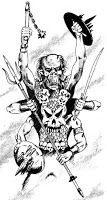 Allitur (God of ethics and propriety) LG(N), Flan origin
Allitur (God of ethics and propriety) LG(N), Flan origin
Atroa (Goddess of spring and the East Wind) NG
Beory (Oerth Mother, Goddess of nature, rain) N, Flan origin
Berei (Goddess of home, family, and agriculture), NG Flan origin
Bleredd (God of metal, mines, and smiths) NC
Boccob (God of magic and arcane knowledge) N
Bralm (Goddess of insects and industriousness) N(L), Suel origin
Celestian (God of the stars, space, and wanderers) N(G)
Saint Cuthbert (God of wisdom, dedication, and zeal) LG(N)
Delleb (God of reason and intellect) LG
Ehlonna “of the forests” (Goddess of forests, flowers, and meadows) NG
Erythnul (God of hate, envy, malice, and panic) CE(N)
Fharlanghn (God of horizons, distance, and travel) N(g)
Geshtai (Goddess of lakes, rivers, and wells) N, Baklunish origin
Heironeous (God of chivalry, honor, justice, and valor) LG
Hextor (God of war, discord, and massacre) LE
Incabulos (God of evil, plagues, and nightmares) NE
Joramy (Goddess of fire, volcanoes, anger, and quarrels) N(G)
Kurell (God of jealousy, revenge, and thievery) CN
Lirr (Goddess of prose, poetry, and art) CG
Lydia (Goddess of music, knowledge, and daylight) NG, Suel origin
Myhriss (Goddess of love and beauty) NG
Nerull “The Reaper” (God of death, darkness, and the Underworld) NE, Flan origin
Obad-hai (God of nature, wildlands, freedom, and hunting) N, Flan origin
Olidammara (God of music, revelry, rougery, and wine) NC
Pelor (God of the sun, strength, light, and healing) NG, Flan origin
Pholtus (God of light, resolution, and law) LG(N)
Procan (God of the oceans, seas, and salt) NC
Rao (God of peace, reason, and serenity) LG, Flan origin
Ralishaz (God of chance, ill-luck, and misfortune) CN(E)
Sotillion (Goddess of summer, the South wind, ease, and comfort) CG(N)
Telchur (God of winter, the North wind, and cold) CN
Trithereon (God of individuality, liberty, and retribution) CG
Ulaa (Goddess of hills, mountains, and gemstones) LG, unknown origin
Velnius (God of the sky and weather) N(G)
Wenta (Goddess of autumn, the West wind, and the harvest) CG
Xan Yae (Goddess of twilight, shadows, stealth, and mind over matter) N, Baklunish origin
Zilchus (God of power, prestige, influence, money, and business) LN
Zodal (God of mercy, hope, and benevolence) NG
I’m deliberately leaving demi-gods out of this listing, as I think they have a different status in the context of cultural pantheons that I’ll address at a later time.
We have a few Divine Groupings here. Atroa/Sotillion/Telchur/Wenta are an obvious first choice, but it is interesting to note that their genders seem a tad out of whack. Three females and one male. Indo-European tradition allows for Divine Twins to be of either gender (Pollux and Castor, for example, or Freyja and FreyR), but a four-way split seems intuitively to want two males and two females. But it is not so. Perhaps Atroa(spring)/Wenta(autumn) and Sotillion(summer)/Telchur(winter) function as a sister/sister sister/brother combination. Perhaps some Oeridian myth recalls the bitterness felt by Telchur at being the “odd man out” (literally) and thus his affinity with the harshest time of the year. Pehaps Velnius would be their father, and this would be a myth that originated with the Oeridians?
The brotherhood/rivalry between Hextor and Heironeous is already well-attested. There seems to be a bit of a brotherly rivalry between Celestian and Fharlanghn as well, but its nature is unknown to us. Why, exactly, does Fharlanghn wander endlessly?
It’s interesting that both the “noble” warriors-for-Good Gods (Saint Cuthbert, Heironeous, and Pelor) as well as the “soft” Good Gods (Allitur, Delleb, Rao, and Zodal) are here. I think it’s possible the two leanings of Good; “active” vs. “passive” could have a mythological conflict.
What I find ultimately fascinating is that, looking at things from a pantheonic perspective, “common” deities like Boccob could be very different in an Oeridian church than he would be in a Suel temple. I’d probably do a whole new write-up for each, one for each perspective (i.e., pantheon).
In terms of numbers, 19 members of the pantheon have Good as part of their alignment. Only 5 have Evil. 10 are Lawful and 8 are Chaotic. A full 29 have at least some part of Neutrality (I’m pretty sure that is a trend we’ll see throughout this exercise, and it’s a function of Gary Gygax’s innate sense that deities should be ambivalent at least on some level). There are 39 deities in all, 25 male and 14 female.









Great stuff. I'd be very interested to hear more comment on design intent and regional/racial differences of the faiths.